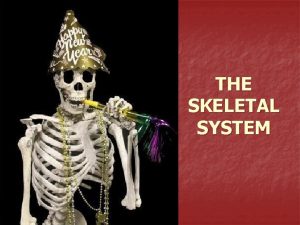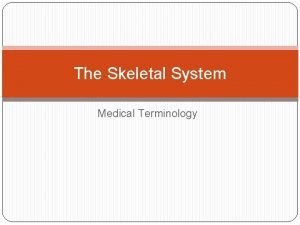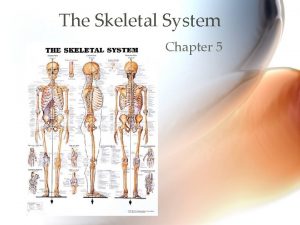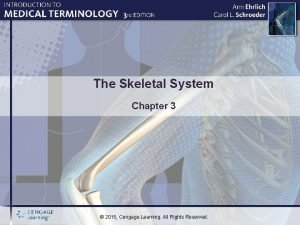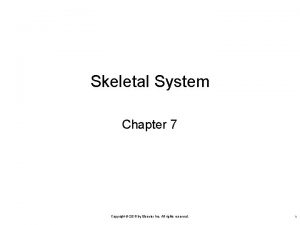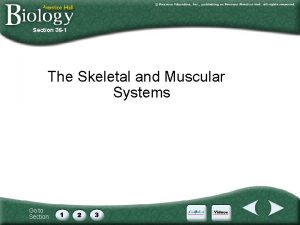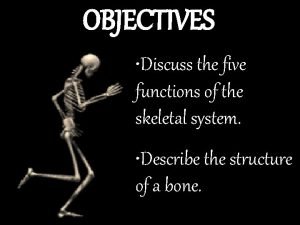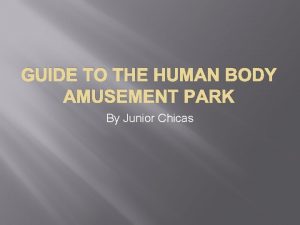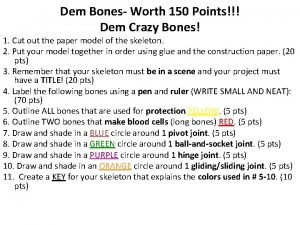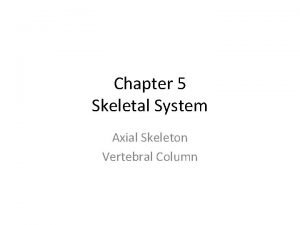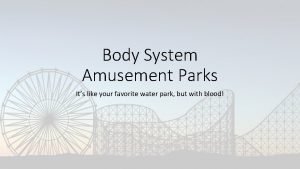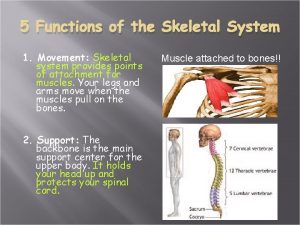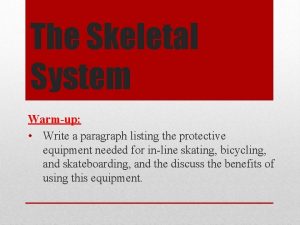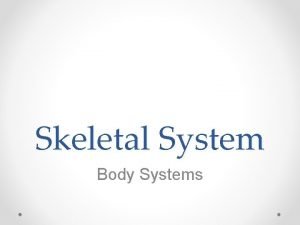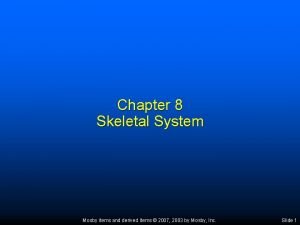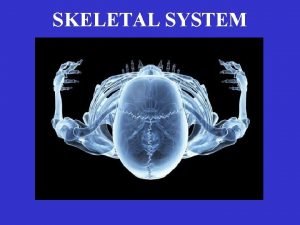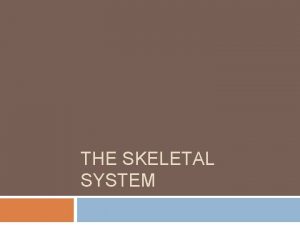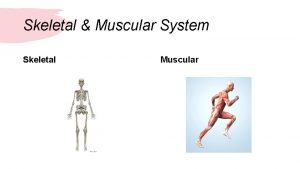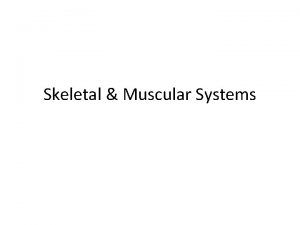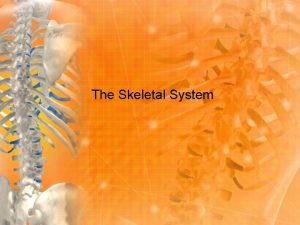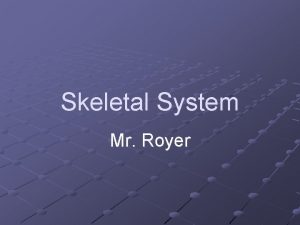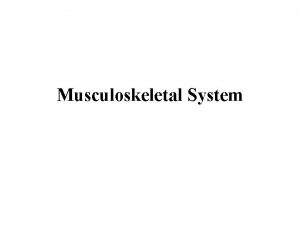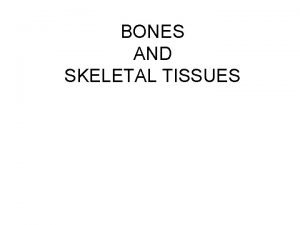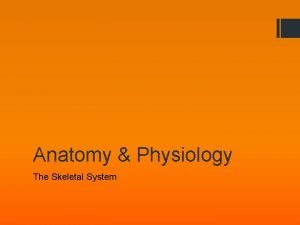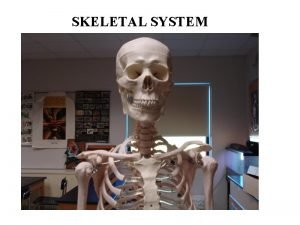The Skeletal System The Skeletal System The skeletal





















- Slides: 21

The Skeletal System

The Skeletal System • The skeletal system protects and supports the body. – Skeleton = Greek word meaning “a dried body” • Functions: 1. 2. 3. 4. 5. Provides shape Provides support and protection Allows movement Stores minerals Produces blood

Bones • Bones are living tissues that can grow and repair themselves, Connective tissue. – Connective tissue provides support for your body and connects all its parts. • Types of Connective Tissue: 1. Bone – provides support and shape. 2. Blood – delivers food and oxygen to the cells and carries away wastes. 3. Fat – keeps the body warm, cushions structures and stores energy.

Formation of Bone • At birth humans have more than 300 bones. • As humans grow and develop, bones grow longer and fuse together. – By age 18 bones are completely ossified (hardened) and stop growing longer. • An average adult has 206 bones.

Bone Composition • Bones are composed of three layer of connective tissue: 1. Periosteum – outermost layer • contains blood vessels that bring nutrients and oxygen to the bone. 2. Compact bone – dense layer of bone • consists of blood vessels, nerve cells, and living bone cells. 3. Spongy bone – located in the ends and middle of long bones. • Porous and lightweight but strong and supportive. • Contains bone marrow.

Bone Composition

Other Components of Bone • Bone Marrow White Blood Cells Red Blood Cells – Located inside the spongy bone. – 2 Types: 1. Red Marrow – produces red and white blood cells. – 2. Produces 500 billion red blood cells per day! Yellow Marrow – fat cells that store energy. Fat

Cranium Mandible Clavicle Humerus Metacarpals Phalanges Scapula Sternum Ribs Vertebral Column Pelvic Girdle Radius Ulna Carpals Femur Patella Tibia Fibula Metatarsals Tarsals Phalanges

Total Bone Count by Category

Bone Classification Long Bones Flat Bones Irregular Bones Sesamoid Bones Short Bones

Bone Classification 1. Long Bones – longer than they are wide. – have a shaft with heads at both ends. – Contain mostly compact bone. Examples: • Humerus, Radius, Ulna, Femur, Tibia, Fibula, Clavicle, Metacarpals, Metatarsals and Phalanges

Bone Classification 2. Short Bones – Cube shaped. – Generally spongy bone. Examples: • Carpals and Tarsals

Bones of the Hands & Feet Hands Carpals Metacarpals Phalanges Feet Tarsals Metatarsals Phalanges

Bone Classification 3. Flat Bones – Thin and flat. – Usually curved.

Male vs. Female Pelvic Girdles Male Pelvic Girdle Female Pelvic Girdle

Bone Classification 4. Irregular Bones – – Irregularly shaped. Do not fit into any other bone classification. Examples: – Vertebrae – Sacrum – Mandible

Bone Classification 5. Sesamoid Bones – embedded in tendons and usually related to joint surfaces. – modify pressure, to diminish friction, and occasionally to alter the direction of a muscle pull. Examples: – Patella

Joints • A place where two or more bones meet – Joint – 2 types: A. Immovable • Immovable Joints – NO movement § Cranium B. Movable • Ball-and- Socket = widest range of movement § Shoulder and hip • Gliding – some movement in all directions § Wrist and ankles • Hinge – only back and forth § Elbow and knee • Pivot – one bone rotates around another § Forearm, neck

Joint Types Ball and Socket Hinge Knee - Hinge Immovable Pivot Gliding Hip - Ball and Socket

Tendons & Ligaments

Cartilage • Located between two adjoining bones. • Cushions bones from sudden jolts • Provides a slippery surface to reduce friction. Cartilage between Femur and Tibia Cartilage
 Five functions of the skeletal system
Five functions of the skeletal system Medical terminology skeletal system
Medical terminology skeletal system Skeletal system
Skeletal system Chapter three skeletal system kaplan
Chapter three skeletal system kaplan Chapter 7:4 skeletal system
Chapter 7:4 skeletal system Chapter 5 the skeletal system
Chapter 5 the skeletal system Section 36-1 the skeletal system
Section 36-1 the skeletal system What are the five functions of the skeletal system?
What are the five functions of the skeletal system? Park of body
Park of body Dem crazy bones answer key
Dem crazy bones answer key Chapter 6 skeletal system
Chapter 6 skeletal system Axial skeleton vertebrae
Axial skeleton vertebrae Chapter 32 section 2 the skeletal system answer key
Chapter 32 section 2 the skeletal system answer key Digestive system amusement park names
Digestive system amusement park names 5 functions of skeletal muscle
5 functions of skeletal muscle Forearm
Forearm How to take care of your skeletal system
How to take care of your skeletal system Crash course skeletal system
Crash course skeletal system Whats the main function of the skeletal system
Whats the main function of the skeletal system Chapter 8 skeletal system
Chapter 8 skeletal system Chapter 7:4 skeletal system label the skeleton
Chapter 7:4 skeletal system label the skeleton Axial skeleton chapter 5 the skeletal system
Axial skeleton chapter 5 the skeletal system
